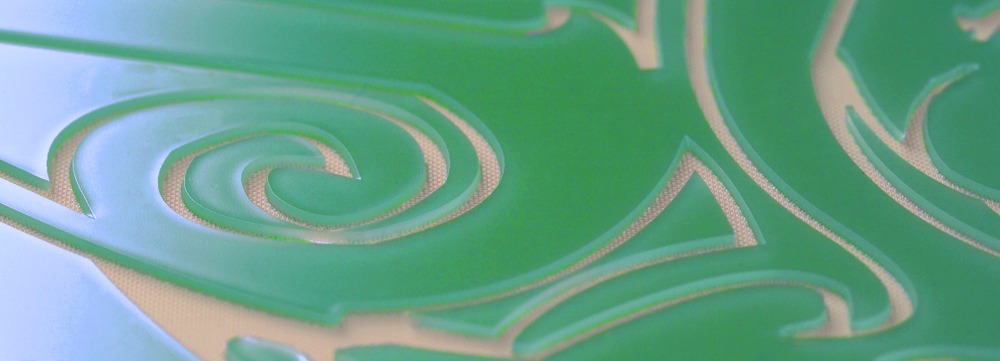
It’s Time To Get PHAT… Super PHAT

By Mick Orr, Applications Training Specialist for Chromaline
Download the article as a pdf >>
Sometimes it’s just plain difficult to do certain jobs. Like putting in a new sidewalk, or printing manhole covers. Know what I mean? Or how about making bullet proof vests? Well, folks all those problems can now be solved by using the latest technology introduced by Chromaline.
What is this latest technology, you ask? The answer to your problems is Super PHAT High Density Capillary Film. OK, so it can’t quite do those things, but it sure can make a thick stencil in no time at all. You can make PHAT film thick enough to trip over. So what is PHAT film? How do I use it? Why do I want it?
What is Super PHAT Film?
Super PHAT film is a pure photopolymer film. It is very easy to use and has many applications. We weren’t the first on the block to have a thick film, but we were the first to have a thick film that is easy to use! This film can be applied to the mesh by Direct/Indirect method. It can also easily be piggy-backed to create any thickness needed. The thicknesses that are available are: 100, 150, 200, 250, 300, 350, 400 and 700 micron. All of these films are easily attached to mesh.
Screen Printing With High Density Capillary Film
Even though the making of the stencil is easy, it can be another story when it comes to the actual printing. PHAT film is not for everyone. It requires high tension mesh and semi-automatic printing equipment and a lot of press adjustment if you are printing textiles. I think that the only one capable of manually printing high density ink and PHAT film is the Incredible Hulk. It takes a lot of muscle to push the high density ink through the thick stencil.
PHAT film isn’t just for high density plastisol inks. It is designed to work for anyone needing a thick stencil such as gasket printers, peelable solder mask and who knows what else.
PHAT film is by far the easiest thick film to apply. It is supplied in a variety of sizes, including rolls and cut sheets. In tests conducted at Chromaline and at many of our customers, PHAT film dries much faster than any of the competition. It also works not only for plastisol ink but for UV, and solvent based inks.
Watch Video on Applying Super PHAT Film >>
What Makes Super PHAT Film Different?
PHAT film is unlike any other film stencil. It’s similar to capillary in that it is presensitized but that is where it ends. PHAT film is not like those other “pthin” films. PHAT film doesn’t sink into the mesh the way a typical capillary film does. Because of this, it’s best to use the Direct/Indirect method of application.
PHAT Film Application
If you are unfamiliar with it, the following is a quick description of the method that we recommend for PHAT film application.
- Start with a clean screen stretched to around 40 to 60 Newtons. The tighter the better.
- Prepare the laminating emulsion. We recommend MAX-R emulsion because of it’s durability. (You can use any of our other emulsions in conjunction with PHAT film).
- Lay the PHAT film on a build up board smaller than the inside dimension of the screen and remove the protective cover from the film.
- Set the screen squeegee side up onto the film and pour a bead of emulsion at one end of the screen. With a round edge medium durometer squeegee draw the emulsion across the screen. Repeat the process a few times. Then, dry the screen for approximately 15 minutes.
- Now pour the emulsion into a scoop coater (coating trough) and apply 2 consecutive coats to the squeegee side of the screen and redry.
- Once it’s dry, remove the carrier. Note: The carrier does not peel off the film as easily as capillary film. Drying time can be as short as one hour. Drying depends on the drying conditions (PHAT film can be dried at temperatures up to 110° F without any “orange peel” effect).
- Attach the photopositive and expose to ultra violet light.
- This stencil must be developed using a high pressure washer. A garden hose won't do.
- Dry and print.
- When it comes time to reclaim the stencil, use Chroma/Strip? and apply it to the squeegee side of the screen. Wait a few minutes then pressure wash the squeegee side of the screen. The stencil will come off in large pieces that can easily be thrown into the garbage.
PHAT film is easier to apply than the competition. It is supplied in rolls and better sizes than the competition. It dries much faster than the competition. It works with solvent, UV and plastisol inks.
This is truly a unique product that is worth checking out. It's the best thing since PHAT sliced bread.
Mick Orr, Chromaline's Technical Guru and Applications Training Specialist has been in the screen printing industry since 1970 with printing experience in a wide range of applications from membrane switches, to textiles, specialty graphics to faceplates and more. If you have any additional questions about drying screens or the screen printing process, please contact us today.
